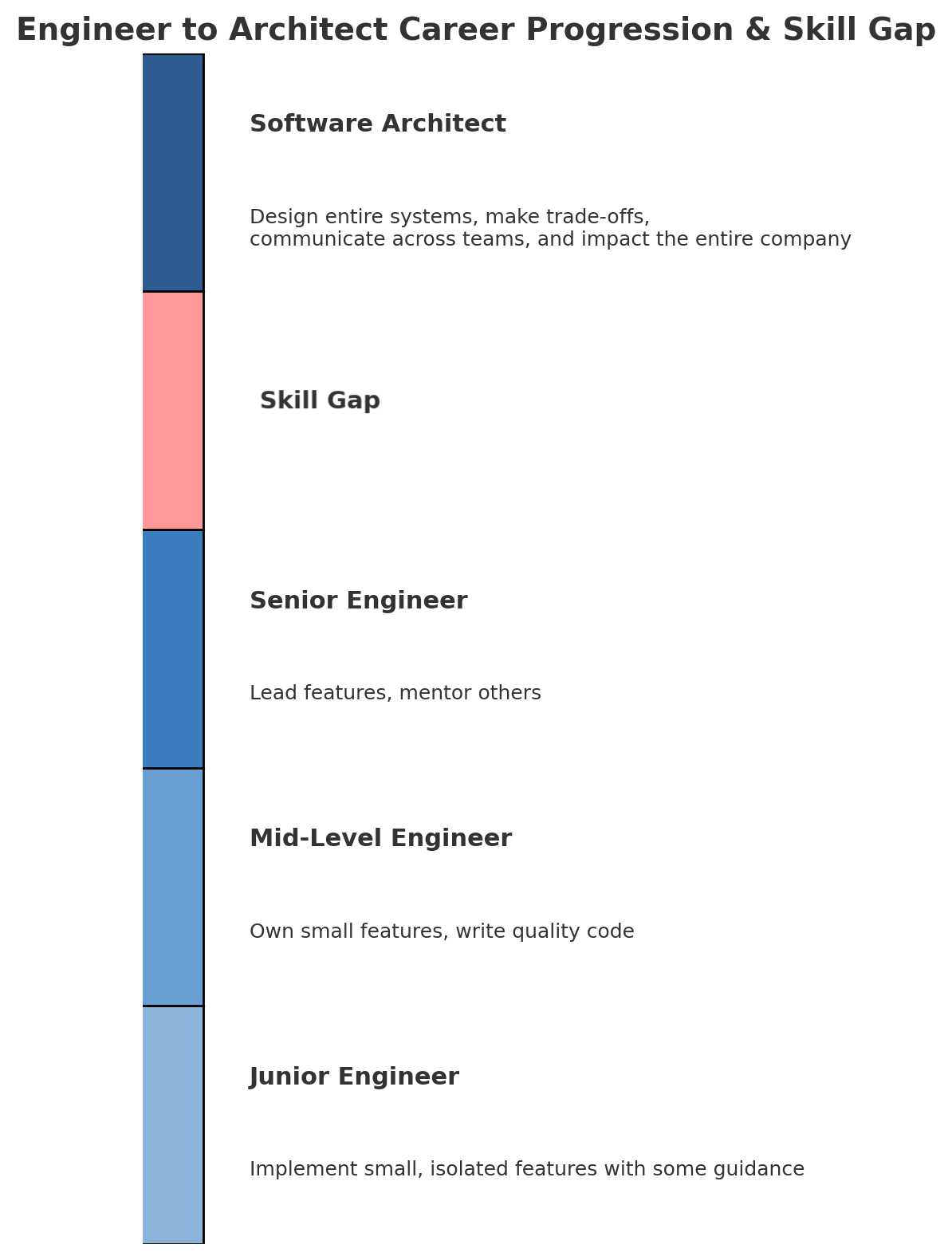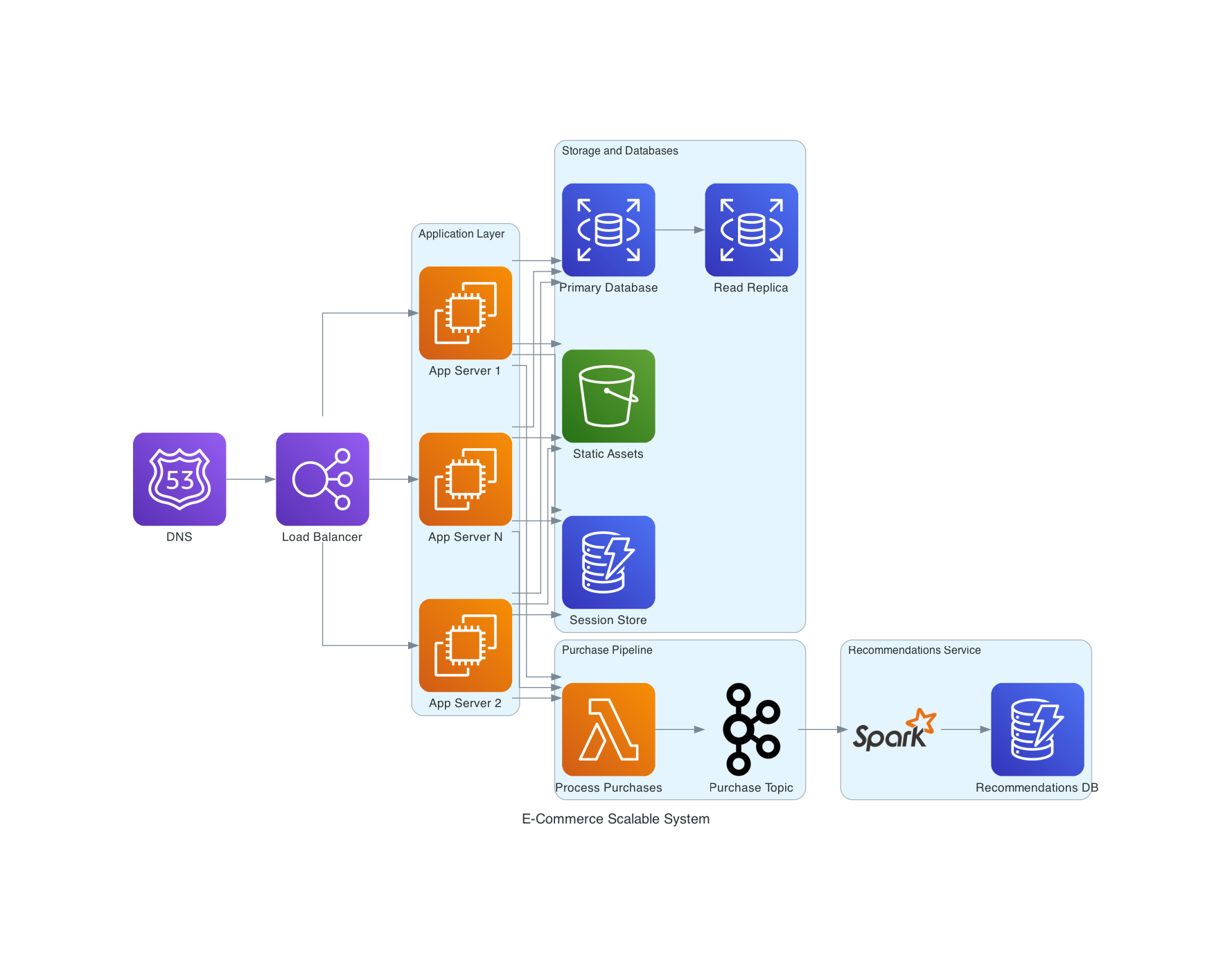How to Become a Software Architect - The Complete Guide
If you’re an experienced software developer and want to take your career to the next level, becoming a software architect is a natural and rewarding next step.
Becoming a software architect and technical lead not only helps you grow your career and increase your impact, but also future-proofs your career against the threat of AI.
However, becoming a technical lead and software architect requires more than just years of coding experience.
In this guide, I’ll walk you through the skills, mindset, and steps needed to transition into a software architect role.
What Is a Software Architect?
A software architect is responsible for high-level technical decisions and the overall structure of software systems. The software architect acts as a bridge between business stakeholders, like product managers, and technical stakeholders, like software developers, QA, and DevOps.
Software architects’ role is to ensure the software product is scalable, maintainable, and aligned with user needs, while at the same time, it is delivered within the allocated time and budget.
Additionally, the software architect needs to ensure that the system can continue evolving over time without accumulating technical debt.
Why Become a Software Architect?
Besides the obvious prestige in being a key decision maker at your company, there are many other reasons software developers would want to grow their careers in software architecture:
Broader Impact – Software Architects influence system-wide decisions, not just individual, isolated features
Higher Salaries – On average, software architects earn 20–40% more than senior software engineers. In certain countries, it’s 100% higher.
Career Advancement - You can continue growing as an individual contributor/software engineer without needing to transition into people management.
Job Security - The entire company depends on the software architect’s vision, knowledge, and guidance, making them virtually irreplaceable
Work Satisfaction - The role of a software architect is one of the most rewarding and exciting in the industry, with a broad spectrum of responsibilities
So now that we understand the role of a software architect and why it’s such a lucrative career path, let’s learn the best way to become a software architect.
Why Becoming a Software Architect is Challenging
Transition from software engineer to software architect is much more challenging than advancing from junior to mid-level or from mid-level to senior software engineer.
The reason for this challenge is that it requires:
Implementation vs High-Level Design
While engineers focus on building features and writing code, software architects design entire systems, balance trade-offs, and have to align with business goals, which even the most senior software engineer is largely not even aware of.
Communication and Soft Skills
A typical software engineer can get away with mediocre verbal and writing skills. However, a software architect needs to be very proficient at talking not only to technical stakeholders but also to non-technical stakeholders.
Software architects also need to be able to communicate and document ideas across teams, using software architecture diagrams, database diagrams, etc.Technical Skills
A typical software engineer is encouraged throughout their career to specialize in one area, such as backend, front-end, security, blockchain, or AI. They are also encouraged to specialize even further, like getting deep into one programming language or framework.In contrast, software architects need to have a broad (as opposed to deep) knowledge of everything.
So, essentially, what makes an excellent software engineer is actually far from what is required from a software architect.
This is why most software engineers get stuck and can’t jump over that skill gap, and become a software architect.
So, how can YOU overcome this skill gap? By proactively following the steps below:
How to Become a Software Architect: 7 Essential Steps
1. Think Big Picture Beyond Code
One of the biggest mindset shifts from software engineer to software architect is moving beyond the “feature”, or even short-term 1-3 months project level, to think in terms of entire systems as well as months and years ahead.
Instead of asking, “How do I build this?”, start asking:
What components do you need? Should you implement it yourself or get an off-the-shelf component?
How will different components of the system interact with each other?
What trade-offs do I need to make between scalability, security, performance, maintainability, cost, and delivery speed?
How will this system evolve over time?
What stakeholders are impacted by your work besides your manager and fellow teammates?
You can practice this mind-shift even in your current role. The next time you’re assigned a feature, look at its dependencies, data flow, and long-term impact. This habit will make you a natural candidate for a role as a software architect.
2. Improve Your Communication and Documentation Skills
Great architects are not just technical experts. They’re excellent communicators.
Even if your design is great, if you can’t communicate it to other engineers or business executives, it will not be implemented.
You’ll need to explain architectural decisions to non-technical stakeholders in plain language, collaborate with developers using precise technical documentation, and create software architecture diagrams that convey complex systems and concepts.
Practical ways to improve:
Start writing short technical documentation for your team
Familiarize yourself with creating architecture diagrams (e.g., C4 model, UML diagrams, etc)
Present small design proposals to colleagues to get comfortable in front of an audience
This skill is so important that it’s a core part of my Certified Professional for Software Architecture - Foundation Level (CPSA-F) training, which covers:
Types of documentation for communicating design decisions, interfaces, and cross-cutting concerns.
Software architecture diagrams include UML sequence diagrams, class diagrams, and component diagrams.
Different software architecture views and levels of abstraction to document deployment topologies, static and dynamic views, etc.
Best practices for communication and documentation of software architecture for technical and non-technical stakeholders.
Standard industry-proven templates for documentation that you can follow.
3. Follow Professional Software Architecture Blogs
Staying updated on the latest practices, trends, and case studies shared by software architects (not YouTube or LinkedIn influencers) will keep your knowledge sharp and relevant.
Some excellent resources include:
Regularly reading from real and experienced software architects will help you develop your architectural thinking and vocabulary.
It may feel a bit daunting at first, but over time it will become easy and fun to follow those blogs.
More importantly, you will realize that the depth and quality of those blogs will directly impact the quality of your work and credibility, since other engineers will continue only learning and talking about new tools and technologies, which make little impact on your journey towards the role of a software architect.
4. Read Professional Software Architecture Books
Books require a big time investment. However, they allow you to go deeper into many topics that just can’t fit into a blog article or even a conference talk.
Some recommended starting points:
Fundamentals of Software Architecture by Mark Richards & Neal Ford
Software Architecture in Practice by Len Bass, Paul Clements & Rick Kazman
Designing Data-Intensive Applications: The Big Ideas Behind Reliable, Scalable, and Maintainable Systems by Martin Kleppmann
While reading, focus on understanding why certain architectural decisions are made, not just how they’re implemented. These insights will help you in making trade-offs and design decisions at your work.
5. Go to Software Architecture Conferences
Conferences are a goldmine for not only learning software architecture but also networking with like-minded individuals. You’ll gain exposure to new technologies, software architecture trends, and hear stories from architects working in the field, solving real problems.
Some great conferences to consider:
QCon Conferences Software Architecture Track - Typically taking place in San Francisco, London, Munich, and New York
iSAQB Software Architecture Gathering - An annual event happening in November, Berlin, Germany, organized by iSAQB
Goto Conferences - Gathers the brightest minds in the software community to help developers tackle projects today, plan for tomorrow, and create a better future.
If you can’t attend in person, look for virtual options or recorded sessions on their websites or on YouTube.
Conferences are a great resource, but just like books, they can be quite time-consuming. But if you have the time and resources to attend them, they are totally worth it.
6. Get a Software Architect Certificate
Obtaining a software architecture certification can be an effective way to close the skills gap, boost your credibility, and stand out in a competitive job market.
While certifications are not a strict requirement for most software architects’ roles, the right certification program can give you a clear framework for thinking about architectural decisions and a credential that signals your expertise to employers.
There are several well-known software architecture certification programs, each focusing on a different area:
TOGAF
One of the most recognized certifications in architecture, but it is primarily aimed at Enterprise Architects, dealing with organizational processes and enterprise-level strategy. It’s valuable if you want to work at the intersection of business and IT strategy, but it’s not focused on the day-to-day skills of a software architect.
Cloud Certifications (AWS, Azure, GCP)
These are great for solutions architects or engineers who need to specialize in a specific vendor’s ecosystem, either for regulatory reasons or because their company heavily depends on a specific cloud vendor. While those certifications cover cloud vendor-specific services in depth, they do not teach the foundational principles of software architecture.
SEI Software Architecture Professional Certificate
Offered by the Software Engineering Institute at Carnegie Mellon University, this certificate has strong academic credibility. However, it is highly theoretical and less focused on practical, real-world applications, which are required in the industry.
iSAQB® CPSA-F (Certified Professional for Software Architecture – Foundation Level)
The CPSA-F software architecture certification is designed by experienced software architects in the industry. This certification is vendor-neutral and is highly practical. It covers fundamental principles, architectural styles, quality attributes, trade-offs, and documentation techniques that apply to any company regardless of the technology stack.
7. Take a Professional Software Architecture Training
If you’re a busy professional and reading articles, books, or going to conferences isn’t possible, consider a structured and time-effective professional training like the Certified Professional for Software Architecture - Foundation Level (CPSA-F) by Top Developer Academy.
This training distils all the knowledge from the best resources on software architecture and presents it in a very easy-to-follow online video course.
Participants of this training learn to:
Design an effective software architecture for your system
Ensure the fulfillment of complex project requirements
Apply industry-proven design principles, patterns, and best practices
Evaluate and assess the quality of the software architecture
Document and communicate design decisions, interfaces, and cross-cutting concerns
The CPSA-F training by Top Developer Academy is taught by Michael Pogrebinsky, an experienced software engineer and software architect who’s worked for some of the top tech companies like Google, Intel, Magnite, and others.
He’s also an experienced software architecture instructor with more than 200,000 learners on Udemy and is an accredited CPSA-F trainer by iSAQB.
Michael Pogrebinsky’s teaching style emphasises practical examples and real-life scenarios rather than just learning theory, with no fluff or fillers, which is perfect for highly focused micro learning.
In addition to being highly effective at preparing learners for taking on the role of a software architect, this CPSA-F training is also accredited by the International Software Architecture Qualification Board, a global standard in training and certification of Software Architects.
By the end of the course, students are fully prepared to pass the CPSA-F exam and earn the iSAQB® CPSA-F certification - A valuable and tangible asset that signals potential employers or managers that you have the necessary skills to step into the role of a software architect.
























If you’re an experienced software developer and want to take your career to the next level, becoming a software architect is a natural and rewarding next step.
Becoming a software architect and technical lead not only helps you grow your career and increase your impact, but also future-proofs your career against the threat of AI.
In this guide, I’ll walk you through the skills, mindset, and steps needed to transition into a software architect role.